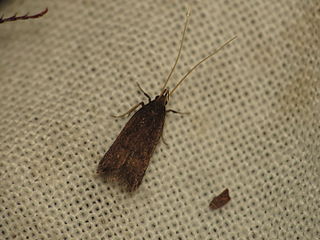
Lecithocera is a genus of moths in the lecithocerid subfamily Lecithocerinae. The genus was erected by Gottlieb August Wilhelm Herrich-Schäffer in 1853.
Lecithocera acrosphales is a moth in the family Lecithoceridae. It was described by Edward Meyrick in 1918. It is found on Madagascar.
Lecithocera caecilia is a moth in the family Lecithoceridae. It was described by Edward Meyrick in 1918. It is found in Sri Lanka.
Lecithocera frustrata is a moth in the family Lecithoceridae. It was described by Edward Meyrick in 1918. It is found in the Central African Republic.
Lecithocera integrata is a moth in the family Lecithoceridae. It was described by Edward Meyrick in 1918. It is found in southern India.
Lecithocera malacta is a moth in the family Lecithoceridae. It was described by Edward Meyrick in 1918. It is found on Grande Comore in the Comoros, which are in the Indian Ocean.
Lecithocera anympha is a moth in the family Lecithoceridae. It was described by Edward Meyrick in 1916. It is found in northern Australia.
Lecithocera cucullata is a moth in the family Lecithoceridae. It was described by Edward Meyrick in 1914. It is found in Mozambique.
Lecithocera cyamitis is a moth in the family Lecithoceridae. It was described by Edward Meyrick in 1904. It is found in Australia, where it has been recorded from Queensland.
Lecithocera imprudens is a moth in the family Lecithoceridae. It was described by Edward Meyrick in 1914. It is found in Australia, where it has been recorded from New South Wales and Queensland.
Lecithocera isomitra is a moth in the family Lecithoceridae. It was described by Edward Meyrick in 1914. It is found in Malawi.
Lecithocera linocoma is a moth in the family Lecithoceridae. It was described by Edward Meyrick in 1916. It is found in northern Australia.
Lecithocera nomaditis is a moth in the family Lecithoceridae. It was described by Edward Meyrick in 1916. It is found on the Solomon Islands.
Lecithocera obsignata is a moth in the family Lecithoceridae. It was described by Edward Meyrick in 1914. It is found in Malawi.
Lecithocera poliocoma is a moth in the family Lecithoceridae. It was described by Edward Meyrick in 1916. It is found in northern Australia.
Lecithocera protoma is a moth in the family Lecithoceridae. It was described by Edward Meyrick in 1914. It is found in Ghana.
Lecithocera sobria is a moth in the family Lecithoceridae. It was described by Edward Meyrick in 1904. It is found in Australia, where it has been recorded from New South Wales.

Lecithocera terrigena is a moth in the family Lecithoceridae. It was described by Edward Meyrick in 1904. It is found in Australia, where it has been recorded from New South Wales and Tasmania.
Lecithocera xanthochalca is a moth in the family Lecithoceridae. It was described by Edward Meyrick in 1914. It is found in Malawi and the Democratic Republic of Congo.

